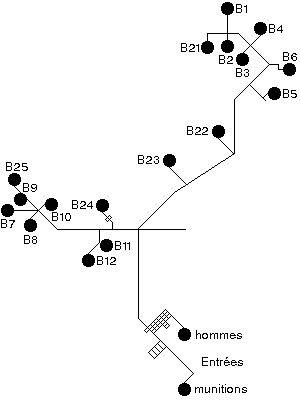The Hackenberg is the biggest fortified sector with 19 bunkers of different types, connected by tunnels.
Position :

blocks 21 to 25 are covering an AT ditches and pinetree lines with barbed wires.
Armament :
8x 75 mm cannons - howitzer in bunkers (75mm mle 1929) or retractable turrets (75mm mle 1933 with semi-automatic loading). The maximum range is about 12000 m, 12-13 shells/minute.
1x 75mm mle 1932 (short) in a bunker protecting an AT ditch.
5x 135mm mortars mle 1932 in bunkers or retractable turrets (range 5600 m and about 8 shells/minute)
4x 81mm mortars mle 1932 in retractable turrets (15 shells/minute, range 3600 m)
7x 37 mm mle 1934 AT guns (15 shells/minute, effective range 800 m)
30x Reibel MAC 1931F 7.5x54 mm MGs (15 twinnings in bunkers, retractable turrets or blocks) (500 or 750 rpm, effective range about 600 m)
61x FM 24/29 7.5 mm (two of them in a twinning protecting the ammo dump with special 70 rounds magazine for each)
caliber : 7.5x54 mm
range : 600 m
RoF : 600 rpm or single shot
capacity : 20 cartridge magazines
V° : 820 m/s
3x 50 mm mortars in bunkers
30x 50 mm mortars in GFM armored "cloche"
3x 60 mm mortars in GFM armored "cloche"
29x grenade launchers protecting the entrances
«dispositif de Belfort» for activation of grenades placed among the barbed wire nets, pinetree lines, walls and AT ditch
Individual weapons of the 34 officers, 135 NCOs and 872 men (revolver mle 1892, pistols SACM 1935S, MAS 38 SMG, (MAS 36 rifle), Lebel mle 86/93 rifle, Berthier mle 1892 M16 carbine).
Bunkers in the Vosges and along the Rhine area are also armed with Hotchkiss 13.2 mm HMGs.
The French 13.2mm Hotchkiss HMG has been mounted in bunkers (96 HMGs in the Maginot Line), in a twin AA version (270 twin HMGs in 1939), in tanks and vehicles (28 in the Laffly AM 50 armoured car, an unknown number in the Panhard AM 80, an unknown number in the AMR modèle 1935, an unknown number in Renault armoured cars model 1915) but however most of the HMGs were used in the French navy which installed them on double and quadruple mountings. The Japanese, Romanian and Polish navy also used the 13,2 mm Hotchkiss.
It has some AT capacities and is often used in this role against weak armored vahicles which are common in 1939/1940.
Caliber 13.2x96 mm
RoF : 450 rpm
capacity : 30 cartridges magazine
different cartridges :
- mle 1935 P (armor piercing) penetration of 25 mm at 100 m, 20 mm at 200 m and 15 mm at 400 m
- ordinary cartridge (penetration of 17 mm at 200 m)
- tracer bullet
range : 2500 m
V° : 800 m/s
Sighting optic : 2.3x
served by 4 men
In comparison the Boys AT rifle was of spectacularly poor performance, it had a penetration of only 12 mm at 100m and 10 mm at 500m (however the weapon's practical usage ended at 300m)
Munitions that have been used in Hackenberg in May/June 1940 :
75 mm guns : 8050 rounds
81 mm mortars : 2340 rounds
135 mm mortars : 1336 rounds
50 mm mortars : 600 rounds
7.5 mm cartridges : 110 000 rounds
illuminating flares : 280
It was shortly attacked once by the germans but they were pulled back and never tried again.
French losses : 2 KIA, 6 WIA.I have no details about this engagment.

drawing from the site
http://www.maginot.org/
and a "naive" drawing :



